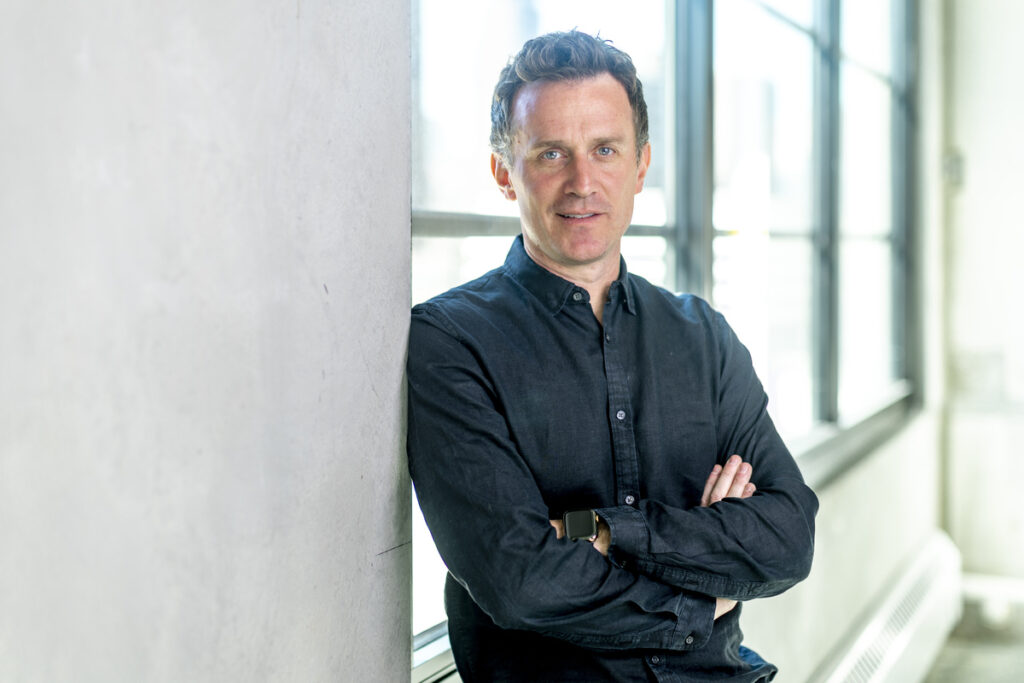A device that allowed a paralysed patient to tweet using thoughts alone has earned two Australian researchers a prestigious award nomination.
Two Australian researchers who developed an implant that allowed a patient with motor neuron disease to send a tweet from his brain have been named as finalists in the European Inventor Award 2023.
Associate Professor Thomas Oxley and Professor Nicholas Opie, both of the University of Melbourne, are among just 12 individuals and teams selected from hundreds of entries to vie for the award’s Popular Prize.

Thomas Oxley of Synchron in Brooklyn, NY on March 30, 2023. Photo by Adam Glanzman

Professor Nicholas Opie
The Stenrode is an endovascular brain implant the size of a paperclip that is designed to record or stimulate the brain or nerves from within the blood vessels.
The device is inserted into a blood vessel within the motor cortex, an area of the brain that controls sensory and motor activity, and it becomes incorporated into the wall of the blood vessel like a tattoo.
Using a brain-computer interface system known as the “Synchron switch”, the device records brain signals from different parts of the motor cortex, interprets the signals and converts them into digital outputs that can be used to control assistive technology such as a robotic limb, computer, wheelchair or exoskeleton.
Professor Oxley said the device was potentially life-changing for people with severe paralysis or neurological disorders.
“Brain computer interfaces are a game changer because there is currently no treatment for paralysis, there is no treatment for a dead nerve cell,” he said.
“This technology bypasses a broken body and lets patients control external devices in a way that wasn’t ever previously considered possible.
“We’re using Bluetooth to bring the raw brain data out of the body from the transmitter. Then we have an external wireless device that receives the signal. It also has Bluetooth and wi-fi capability, and that’s where the decoding algorithm lives.”
Implanting the device is a relatively low-risk procedure, and patients stay in hospital for an average of two days. Additionally, because the device is inserted in the jugular vein, doctors don’t need to perform invasive brain surgery.
Professor Oxley is a vascular and interventional neurologist and an expert in brain-computer interfaces, while Professor Opie is a biomedical engineer and expert in neural interfaces. Their collaboration led to the founding of Synchron in 2016, a US-based company specialising in developing implantable neural interfaces for the treatment of neurological disorders.
In 2021 Synchron received US FDA approval to conduct human clinical trials for a permanently implantable brain-computer interface. The first patients have already received implants – four in Australia and three in the US.
In December 2021, an MND patient in Australia used the device to send a tweet using only his thoughts.
“He trained on the system until he had control of a number of discrete key presses,” Professor Oxley explained. “Then he used those key presses to navigate his way around a keyboard and was able to deliver a low number of characters that created some tweets over a 30-minute period.
“He did it with his family. It was really an incredible moment for him and for his family and for us watching. You know, it was an example where once you have directional control over a mouse and a keyboard, you can do all sorts of things.
“The point was that he had restored his capability to engage with the outside world. And that was what was so powerful. When you have a condition that shrinks your ability to have agency and autonomy in the world, and then it opens back up, it’s very powerful.”
The patient had been severely paralysed, with no use of his arms or voice. Professor Oxley said the device had also changed life for the patient’s wife, who was his carer.
“What really stuck out was the independence that his wife got. So, she used to have to stand near him and make sure that he was okay, if he needed a drink or if he needed to go to the bathroom.
“When we implanted this device and connected him to a phone and allowed him to communicate through text, she was able to go into the garden, she was able to go down the street, and her independence was returned.
“I think, for me, I didn’t appreciate that the technology would have benefits beyond those that we were implanting. And I think seeing how it’s impacted the lives of the people around the patients has been really special.”
Professor Oxley said the Synchron team was growing and preparing the technology to upscale through manufacture and to demonstrate its role in improving the independence of people with certain types of severe paralysis.
Professor Opie said it was still very early days for the technology.
“I think you have to also be aware that it’s going to take a long time,” he said.
“These things don’t happen overnight. We’ve been working on it for 10 years. We’ve still got a long way to go and it’s still exciting.”
Winners will be announced at an online award ceremony on 4 July. See inventoraward.org to find out more.


